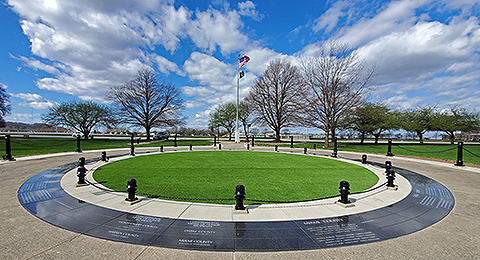World War II soldier from southwest Ohio is coming home
Pictured is Dayton’s Vietnam Veteran Memorial Park. Photo courtesey of Ken Williamson for The VVA Veteran Online.
Stephen Bradley | Contributing Writer
The journey to bring Lt. Dan Corson home to southwest Ohio from northern France has been long and complicated.
Lt. Corson, of Middletown in southwest Ohio, assigned to the 401st Bombardment Squadron, 91st Bombardment Group, Eighth Air Force, in December 1942, was among the many men who fought in World War II and ultimately gave their lives in defense of the United States.
On Dec. 20, 1942, he was co-piloting a B-17F “Flying Fortress” nicknamed Danellen that was shot out of the sky during a bombing raid to destroy a German aircraft factory at Romilly-sur-Seine, France.
Corson’s aircraft was seen crashing near the village of Bernières-sur-Seine. Of the eight airmen aboard the Danellen, one parachuted successfully while the others, including Corson, were still aboard. An eyewitness account from a local villager confirmed there was only one survivor.
A year later, on Dec. 20, 1943, the War Department issued a finding of death for Lt. Corson.
Beginning in 1946, the American Grave Registration Command (AGRC) and the Army Quartermaster Corps,was organized and tasked with recovering missing U.S. personal in European Theater. The AGRC disinterred four sets of remains they designated as X-83, X-84, X-85, and last X-86 St. Andre from Evreux cemetery. They were not able to be identified and were buried at the Normandy American Cemetery.
Until 2011, all seemed lost for the seven souls that were aboard the Danellen. That year, a family member of one of the crewcontacted the Defense Department after visiting the crash site along with interviewing a witness who had artifacts of the Danellen in their possession.
That April, DPAA historians re-analyzed the unknowns associated with the crew and determined there was enough evidence to re-open the case and explore the possibilities of identifying the young men and bringing them home for a proper burial and recognition.
In October 2011, a DPAA Investigation Team traveled to Bernières-sur-Seine to interview the same witness and look over the artifacts associated to the Danellen in their possession. They found the crash site had been destroyed, leaving another dead end.
Despite this, efforts continued to find out who was in that crash site. The effort was long and grueling, but the case was never given up on. Like many that are involved in these cases.
Fast forward to March 2019. The Defense Department and the American Battle Monuments Commission (AMBC) exhumed from the Normandy American Cemetery the unknown remains believed to be associated with the crew of the Danellen, which included Lt. Corson.
To ID Lt. Corson’s remains, DPAA scientists used anthropological analysis. Armed Forces Medical Examiner System scientists were able to use mitochondria DNA (mDNA) and Y-chromosome analysis (Y-STR) analysis to make the identification.
Thanks to these programs and technology, Lt. Corson is able to make his way home to southwest Ohio.
At the time of this article, the funeral had not be scheduled.
This reporter’s attempts to interview Army Casualty Office officials and to interview family members were unsuccessful.
If you want to learn more about Lt. Corson and work being done to recover the remains of U.S. military throughout Europe and other theaters of World War II, contact the Army Casualty Office at (800) 892-2490.
For more news forma round the globe, check out Flyer News’ news page here!

